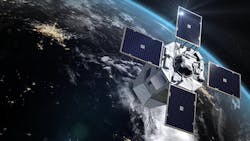IARPA asks for image processing technology using sensor fusion for air- and space-based remote sensing
WASHINGTON – U.S. intelligence experts approaching industry for a image-processing project to blend data from satellite- and aircraft-based multispectral imaging sensors and visible-light sensors to detect activities like heavy building projects and highway construction.
Officials of the U.S. Intelligence Advanced Projects Agency (IARPA) in Washington issued a broad agency announcement last week (IARPA-BAA-19-04) for the Space-based Machine Automated Recognition Technique (SMART) project.
SMART seeks to use sensor fusionto enable automated broad-area search, monitoring, and characterization the progression of natural or man-made activities using time-series spectral imagery from several different satellite- or aircraft-based electro-optical sensors.
Examples include heavy construction, real estate or urban development, crop disease propagation, forest fire, flooding and mud slides, insect or battle damage, human migration, mining, logging, farming, earthquakes.
Related: Multi-sensor fusion hits the mainstream
SMART applications potentially could include geospatial intelligence, disaster recovery, humanitarian aid, and automated assessment of land-use trending.
Today there is no single remote-sensing system with spatial, spectral, and temporal resolution necessary to detect changes over time, IARPA officials point out. SMART aims to use several images from different sensors to provide for persistent monitoring.
The program will focus on two primary technical areas: data fusion; and algorithms to detect and characterize events. Offerors may address one or both of these areas in their proposals.
Data fusion seeks to quantify data quality and cross-sensor inconsistencies in time-series satellite images and develop automated data calibration techniques by blending geometric and radiometric correction, cloud masking, pixel quality, gridding, and collection management.
Algorithms to detect and characterize events or activities over areas larger than 8,000 square meters using space-based time-series imagery. IARPA would like proposers to identify standards like software libraries, data type definitions, architecture guidelines, and software processes that are easy to follow and efficient to carry out.
SMART essentially will rely on geographical information from satellite and aircraft cameras, and develop multi–spectral and multi–temporal sensor processing to overlay data from infrared and multispectral sensors to make the intelligence analyst's job easier.
The idea is to reduce uncertainties inherent in single-sensor data, and reduce the sheer amount of intelligence imagery data that can overwhelm intelligence analysts by developing tools to help analysts analyze intelligence imagery using Big Data, IARPA officials say.
The program will focus on two primary technical areas: data fusion; and algorithms to detect and characterize events. Offerors may address one or both technical areas in their proposals. SMART will be a four-year project that will extend from August 2020 to July 2024.
Related: EO/IR sensors boost situational awareness
Data fusion seeks to quantify data quality and cross-sensor inconsistencies in time-series satellite images and develop automated data calibration techniques by blending geometric and radiometric correction, cloud masking, pixel quality, gridding, and collection management. Algorithms seeks to detect and characterize events or activities over areas larger than 8,000 square meters using space-based time-series imagery.
Proposals shall identify standards like software libraries, data type definitions, and architecture guidelines and software processes that will be easy to follow and efficient to implement.
IARPA officials say they expect to create an infrastructure that will enable analysts to access, calibrate, and process data streams from several satellites simultaneously for time-series analysis.
Companies interested should upload proposals no later than 7 April 2020 to the IARPA Distribution and Evaluation System (IDEAS) Website at https://iarpa-ideas.gov.
Email questions or concerns to IARPA at [email protected]. More information is online at https://beta.sam.gov/opp/65774ed561254fd58d18a48a50bf3170/view.
